Your Body Under Construction

Upon reaching the age of 12, boys in the Brazilian Satere-Mawe tribe face a terrifying test as a rite of passage into manhood. The boys take part in a ceremony where they must put their hands inside a pair of gloves loaded with bullet ants. It is a rite that could make the most courageous of young boys tremble with fear.
The bullet ant inflicts one of the most painful bites of any insect, some 30 times as painful as a bee sting. Their hands are only in the gloves for 10 minutes, but the burning, throbbing pain lasts for 24 hours. And what happens after they survive this ceremony? They must repeat it 19 more times before they are considered true adults in the tribe.
Rites of passage occur in nearly every culture around the world, although most of them are nowhere near as painful or dramatic as the bullet ant initiation. In Jewish culture, the Bar Mitzvah (for boys) and Bat Mitzvah (for girls) ceremonies mark their coming of age as adults at age 13 and 12, respectively. Christians celebrate with confirmation or, in some, cases baptism. In many parts of Latin America, the Quinceañera at age 15 marks the transition for girls from childhood to womanhood.
Our bodies as chemical factories
What is it about the early teenage years that inspires this wide range of ceremony, marking the change from childhood to adulthood? The answer lies in the basic chemistry of human growth and development.
Beginning with the teenage years, the body begins its own “rite of passage” called puberty. The word comes from the Latin puberatum, meaning “age of maturity” or “manhood.” The effects on the human body are relatively quick and substantial. Boys develop facial and pubic hair, voices deepen and muscles grow. Girls develop breasts, change their body composition to include a higher percentage of fat which, along with skeletal changes, give the classic feminine “hour glass” shape to their bodies.
But what causes these remarkable changes? The answer lies in chemical substances called hormones. It is of little surprise that the control of our growth and development is based on chemicals. Although there is little evidence in our everyday lives to make us think so, our entire existence is based on millions and millions of chemical reactions.
Our bodies are amazing chemical factories that build up and tear down body parts constantly. Chemists can keep track of our metabolism by labeling atoms with radioactive material. They discovered that every year, 98% of the atoms in our bodies have been exchanged for new ones. We are always “under construction.” Chemical reactions allow us to get energy and building materials from the food we eat. Chemical reactions control how we move, respond, and heal. There is very little that happens inside our bodies that does not involve a chemical reaction.
Hormones are defined by their action. They are generally produced by small organs called glands and are carried through the bloodstream to other cells where they cause changes. One remarkable feature of hormones is that they can have significant effects on our bodies in doses as small as a few millionths of a gram (micrograms).
In contrast, most of the substances that affect our body are taken in large quantities. Think about the food we eat. We consume several kilograms of food each week, but the short-term effect on your body shape is small. (The long-term effect is a different story!) The daily dose of required vitamins ranges from a few micrograms to several hundred milligrams. But only relatively small amounts of hormones have noticeable effects.
Physical Changes in Males

Although we know hormones are the cause of changes in our bodies at puberty, we still don’t know why it starts all of a sudden in the teenage years. In males, it is all about the hormone called testosterone. This hormone is produced in male testes, which are also known to make sperm.
At the onset of puberty, the testes begin pumping out more and more testosterone. As the level of testosterone increases, the effects on the body begin to take shape. Testosterone is an androgen—meaning it is responsible for the development of male characteristics. These include stimulating growth of the sex organs that make up the male reproductive system, thickening of the skin, beard growth, and muscle growth.
These effects are part of the body’s anabolism—processes that build and grow our bodies. Testosterone is one of a class of hormones called steroid hormones, which are derived from the dietary fat cholesterol (Fig. 1). A steroid is an organic compound that contains four rings that are joined to each other in a particular arrangement.
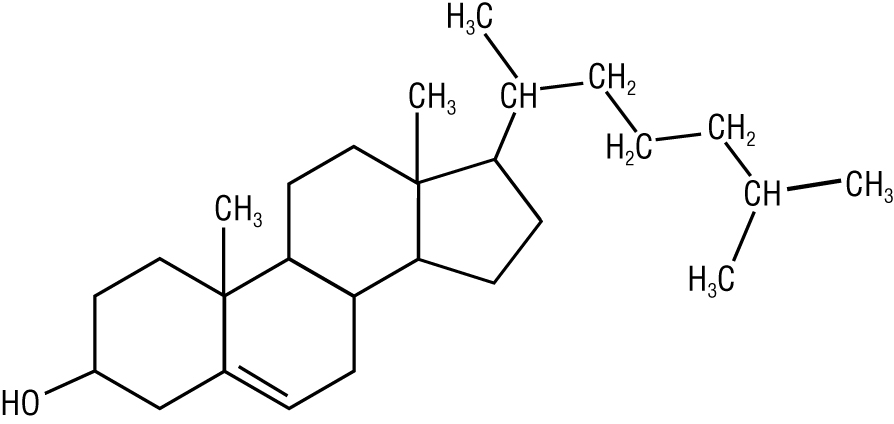
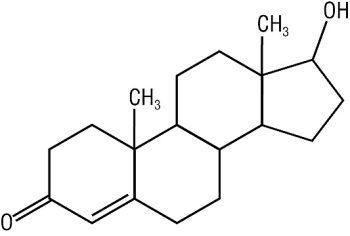
Anabolic steroids are very effective in stimulating muscle growth, which has tempted some athletes to take supplements that contain large doses of these androgens to improve their athletic performance. In addition to the unethical nature of this use, the potential harmful health effects of androgen steroid use is well established. High concentration of steroids from supplements can prevent the release of natural hormones necessary in the production of sperm and leads to temporary infertility. Excess amounts of supplemental testosterone can lead to its conversion to a female hormone, causing breast enlargement.
Form and Function
So, how do these powerful molecules work? They follow the concept of form and function, the principle that the shape of molecules determines how they work. Many chemical mechanisms depend on the shape of molecules for their activity.
Hormones are examples of this concept. It is just like what happens when you put the key into a lock. If the shape of the key is just right, it allows you to turn the key and open the lock. Cells that are affected by a hormone contain “receptors,” which act as locks to which hormones (the “keys”) bind.
Hormone receptors are either on the surface of the cells or on the surface of the nucleus inside the cell. When a given hormone fits into a specific receptor, they are like two jigsaw pieces fitting together.
What happens next depends on the type of hormone. In the case of testosterone, the receptors are found in the nucleus of the target cell. When the testosterone binds to its receptor, it causes the receptor to change shape. This shape change then allows the receptor to attach to a strand of DNA in the nucleus. DNA, or deoxyribonucleic acid, is the chemical responsible for the genetic information that controls the function of the cell.
Binding to specific sites on the strand of DNA causes the production of messenger RNA (mRNA), which carries the genetic information that directs the synthesis of proteins. Since proteins are the main structural materials of our body (muscles, hair, skin, organs), any change in protein production can have a big impact on how we look.
Females also produce testosterone, but only about a tenth as much. Females begin their rite of passage in puberty with other hormones.
Physical changes in females
In girls, puberty starts when their ovaries produce larger amounts of hormone called estrogen. Estrogen is actually a group of compounds such as estradiol (Fig. 2).
The ovaries are the center of the female reproduction process. They not only produce the hormones associated with puberty and fertility, they also shelter and nourish some 500,000 egg cells.
An interesting side note: Although males begin producing sperm at puberty and continue their whole life, a female is born with all the eggs she will ever have. These eggs are stored in the ovaries and released one at a time, in a monthly cycle controlled by hormones.
Like testosterone, estrogen molecules also belong to a class of hormones called steroid hormones. Estrogen molecules are similar to testosterone, in that it affects the appearance and function of the body in many ways. It promotes the layering of fat beneath the skin and accounts for the fact that women tend to have more body fat than men. This accumulation of body fat is particularly true in the breasts and hip areas. It is thought that this is an evolutionary development, as young women begin to become fertile and ready to have babies, it is important they have adequate stored energy, in the form of fat, to be able to nourish their babies.
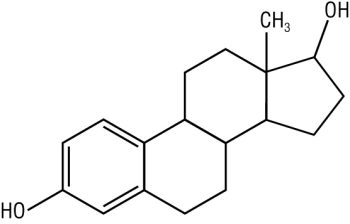
Estrogen also makes the skin smoother and thinner. It has an inhibiting effect on bone growth, accounting for the fact that on average, women are shorter than men. Curiously, estrogen has the opposite effect on the bones of the pelvis, causing them to become wider than in men. Again, this is a change that makes it easier for women to give birth.
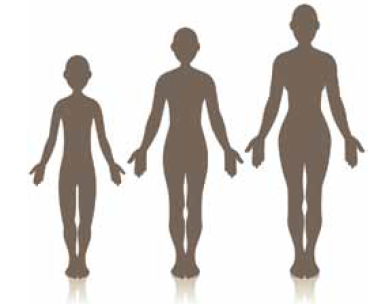
This last observation raises some interesting questions. How can the same chemical messenger cause bones in one part of the body to grow and in other parts to slow down? Testosterone has similar contradictory effects. It stimulates hair growth on the face and body, but can cause baldness on top the head. How can this be?
The answer is not well understood, but likely has to do with the genetics of individual cells. Variations among hormone receptors in individual cells could change everything in the way the hormone alters the cell behavior. We have only looked at a few hormones. There are many other hormones that influence how cells behave.
Hormones and the brain
Hormones can also affect the brain. The changed anatomy of the male brain is significant enough that it can be seen in medical imaging techniques. Two behaviors influenced by testosterone are sex drive and aggression. This kind of behavior is observed all the time in the animal world. The largest and most aggressive wolf in a pack is more likely to breed with females, and have its genes passed on to the next generation.
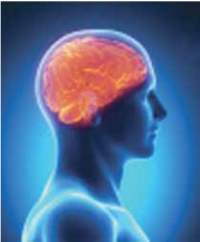
Likewise, estrogen affects female behavior. It has an influence on sexual arousal and can also affect food intake. High levels of estrogen tend to suppress appetite in females, while low levels have the opposite effect. This increase and reduction in appetite seems to be related to pregnancy, ensuring there is adequate nutrition for growing babies.
There is some evidence that links estrogen levels to eating disorders such as anorexia nervosa or bulimia. Also, if a female becomes very lean from dieting, exercise or starvation, her reproductive cycle will be inhibited. This again seems to be a natural safeguard that prevents pregnancy when there does not seem to be enough body fat to nourish a baby during pregnancy.
The hormones associated with puberty and sexual development are filling just one of the many roles hormones play in human metabolism. There are many examples of basic human systems that are under the control of hormones.
The hormone insulin is a great example. Insulin is essential in the ability of cells to take in glucose molecules that provide energy to our cells. Lack of adequate insulin restricts the cells’ ability to take in glucose, which results in a medical condition called diabetes. (See the article titled “Changing the Course of Diabetes” on p. 12 in this issue.)
Other hormones regulate blood pressure and heart rate, and a whole class of hormones serves to regulate other hormones. It is a complex and elegant system.
Anyone who has experience puberty can attest to the power and influence of hormones. Fortunately, the changes that accompany it don’t happen overnight, giving teenagers time to adjust. And after all, it could be worse: We could be walking around wearing gloves full of stinging ants!
Selected references
Middlecamp, C. H. et al. Chemistry in Context: Applying Chemistry to Society, 7th ed., McGraw-Hill: New York, 2012.
Brink, S., Modern Puberty, Los Angeles Times, Jan 21, 2008.
Beamish, R. Steroids: A New Look at Performance Enhancing Drugs. ABC-CLIO, Santa Barbara, CA, 2011.
Berger, K. S. The Developing Person Through Childhood and Adolescence, Worth Publishers: New York, 2009.
------------------
Michael Tinnesand is a science writer and education consultant who lives in Portland, Ore. His latest ChemMatters article, “Harnessing Solar Power,” appeared in the October 2011 issue.
Also in this Issue (December 2011)

The Dirt on Getting Clean
Hand sanitizers, antibacterial soaps, regular soaps… What works best and why?

Mmmm... Flavorful Food!
Taste, smell, color, texture… There are many ways to enjoy food. But explaining why food tastes so great is more difficult because of the variety of flavor chemicals involved. Learn about those chemicals and how they contribute to the flavor of food.

